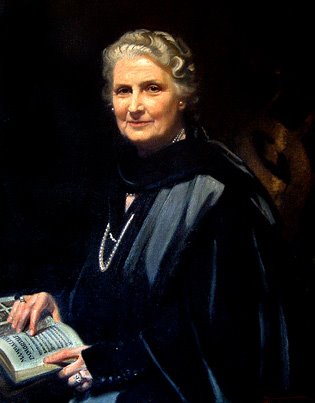Madam Maria Montessori
Maria  Montessori was always a little ahead of her time. At age thirteen, against the wishes of her father but with the support of her mother, she began to attend a boys’ technical school. After seven years of engineering she began premedical studies and, in 1896 became a physician. In her work at the University of Rome psychiatric clinic Dr. Montessori developed an interest in the treatment of special needs children and, for several years, she worked, wrote, and spoke on their behalf.In 1907 she was given the opportunity to study “normal” children, taking charge of fifty poor children of the dirty, desolate streets of the San Lorenzo slum on the outskirts of Rome. The news of the unprecedented success of her work in the “House of Children” soon spread around the world, people coming from far and wide to see the children for themselves. Dr. Montessori was as astonished as anyone at the realized potential of these children,”Supposing I said there was a planet without schools or teachers, study was unknown, and yet the inhabitants – doing nothing, but living and walking about – came to know all things, to carry in their minds, the whole of learning: would you not think I was romancing?” “Well, just this, which seems so fanciful as to be nothing but the invention of a fertile imagination, is a reality.” It is the child’s way of learning. This is the path he follows. He learns everything without knowing he is learning it, and in doing so passes little from the unconscious to the conscious, treading always in the paths of joy and love.
Montessori was always a little ahead of her time. At age thirteen, against the wishes of her father but with the support of her mother, she began to attend a boys’ technical school. After seven years of engineering she began premedical studies and, in 1896 became a physician. In her work at the University of Rome psychiatric clinic Dr. Montessori developed an interest in the treatment of special needs children and, for several years, she worked, wrote, and spoke on their behalf.In 1907 she was given the opportunity to study “normal” children, taking charge of fifty poor children of the dirty, desolate streets of the San Lorenzo slum on the outskirts of Rome. The news of the unprecedented success of her work in the “House of Children” soon spread around the world, people coming from far and wide to see the children for themselves. Dr. Montessori was as astonished as anyone at the realized potential of these children,”Supposing I said there was a planet without schools or teachers, study was unknown, and yet the inhabitants – doing nothing, but living and walking about – came to know all things, to carry in their minds, the whole of learning: would you not think I was romancing?” “Well, just this, which seems so fanciful as to be nothing but the invention of a fertile imagination, is a reality.” It is the child’s way of learning. This is the path he follows. He learns everything without knowing he is learning it, and in doing so passes little from the unconscious to the conscious, treading always in the paths of joy and love.
FROM EUROPE TO THE UNITED STATES
Invited to the USA by Alexander Graham Bell, Thomas Edison, and others, Dr. Montessori spoke at Carnegie Hall in 1915. She was invited to set up a classroom at the Panama-Pacific Exposition in San Francisco, where spectators watched twenty-one children, all new to this Montessori method, behind a glass wall for four months. The only two gold medals awarded for education went to this class, and the education of young children was altered forever.
INDIA and THE NOBEL PEACE PRIZE
During World War II Dr. Montessori was forced into exile from Italy because of her antifascist views and lived and worked in India. It was here that she developed her work, ‘Education for Peace,’ and developed many of the ideas taught in her training courses today. She was twice nominated for the Nobel Peace Prize.
THE ELEMENTARY MONTESSORI PROGRAM
In Rome Dr. Montessori developed the Montessori program for the elementary years for the child from 6-12. She began, as elementary classes do today, with the required curriculum of Italy of her time. She adapted the traditional teacher-taught subjects in the arts and science so that the children could use materials to guide their open-ended research and to follow their individual interests, working to a much higher level than was previously (and is presently!) thought possible for children of this age. The elementary child, when allowed to work independently instead of being taught in groups led by a teacher, and in classes with a mixed age group of 6-12- year-old students inspiring and teaching each other, masters academic subjects usually not taught until middle or high school.
THE MIDDLE SCHOOL AND HIGH SCHOOL PROGRAM
Montessori had many ideas for the child at this age.In 1948,at the invitation of Shrimant Rajmata Vijya Raje Scindia, she started the Montessori system and gave rise to Association of Montessori International Shishu Mandir, Gwalior.Pictures and write up of A.M.I. Shishu Mandir are documented in her books ” The Discovery of the Child” and “The Absorbent Mind.”

